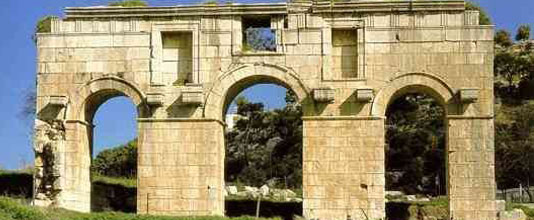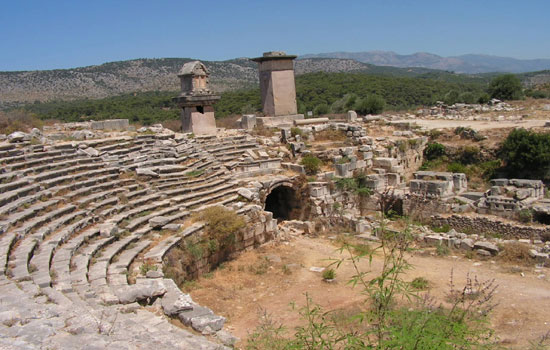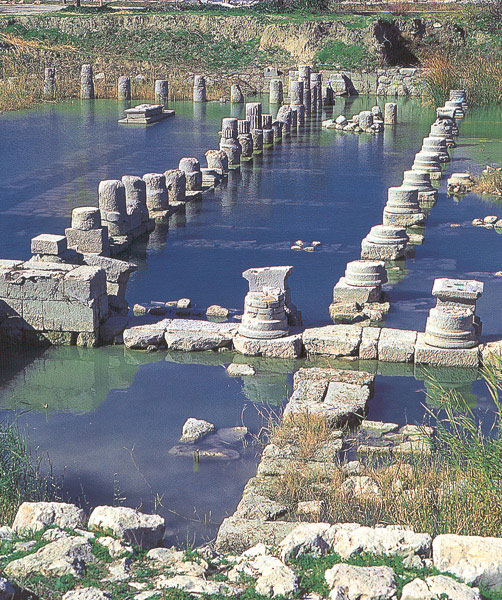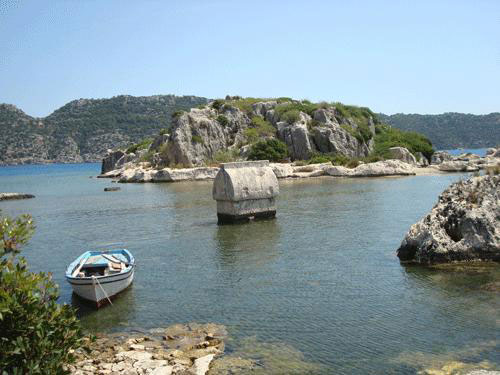Ancient History On Your Doorstep...
Link: 3D Tour of PataraLink: Lycian TurkeyLink: 3D Tour Of Letoon |
Patara
Patara was the major naval and trading port of Lycia, located at the mouth of the Xanthos River, until it silted up and turned into a malaria-plagued marsh. It is not far from the sites of Letoon and Xanthos and a day trip from Kalkan, Kaş or Fethiye could easily combine the sites. Beautiful 12 km-long Patara Beach, voted one of the top beaches in the world by Times Online – Best of 2005, is an easy 10-15 minute stroll away from the major ruins at Patara. The Patara area is a national park, a key biodiversity area and is rich in birdlife. Patara was a very wealthy city due to trade and was one of the six principal cities of Lycia. Patara’s oracle at the renown temple of Apollo (not yet found) was said to rival that at Delphi and the temple equaled the reputation of the famous temple on the island of Delos. It was believed that Apollo lived at Delos during the summer but spent his winters at Patara. Omens were interpreted in these two towns during the respective seasons. A large bust of Apollo, discovered on the hill beyond the City Gate, indicates the existence of an Apollo Temple which has not yet been found. Following its capture by Alexander the Great Patara became an important naval base as well. Alexander promised the revenues of four cities, including Patara, to one of his commanders, thus its value at that time is quite clear. Many legends exist explaining the origin of the name of Patara. During the time of Lycia’s Ptolemy domination, Ptolemaios II (reigned 285-246 B.C) re-named Patara as Arsinoe in honour of his wife. The name did not stick, however, and the original name was soon again in use. Letoon Letoon was the sacred cult center of Lycia, its most important sanctuary, and was dedicated to the three national deities of Lycia – Leto and her twin children Apollo and Artemis. Leto was also worshiped as a family deity and as the guardian of the tomb. Letoon lies less than 10 km to the south of Xanthos on a fertile plain. Xanthos and Letoon are often seen as a “double-site”, since the two were closely linked and Letoon was administered by Xanthos. Xanthos-Letoon is one of the most remarkable archaeological sites in Turkey. For this reason, it has been registered in the UNESCO World Heritage Sites list. Letoon has been under excavation since the 1950’s and since 1962 by the French Archaeological Mission, in conjunction with the excavations being carried out at Xanthos. Excavation goes on today – the team has done some excellent work and in recent years has begun to restore the Temple of Leto. Letoon is a romantic site and many of the monuments arise from standing water which provides lush vegetation. Terrapins and frogs are usually seen. Unfortunately though, the high water table hinders excavation. To reach Letoon, you turn west one km beyond the road from Kinik to Fethiye and continue 5 km. It’s not far from Patara and a day trip from Kalkan, Kaş or Fethiye to Letoon or Xanthos could easily be combined with a trip to the beach and /or ruins there. Letoon was a sanctuary precinct and not actually a city, and seems to have had no major settlement associated with it at any period. It was administered by Xanthos and was the spiritual heart of Lycia, its federal sanctuary and the place of national festivals. Letoon was the center of pagan cults activity until perhaps the 5th century AD when Lycia was ravaged by Arab attacks and the area started to silt up with sand brought by the Xanthos River. It is believed to have been abandonded by the 7th century AD. Archaeological finds date back to the late 6th century BC. During the Archaic and Classical periods (7th-5th century BC) the site was probably sacred to to the cult of an earlier mother goddess (Eni Mahanahi in Lycia), which was later superseded by the worship of Leto. |




